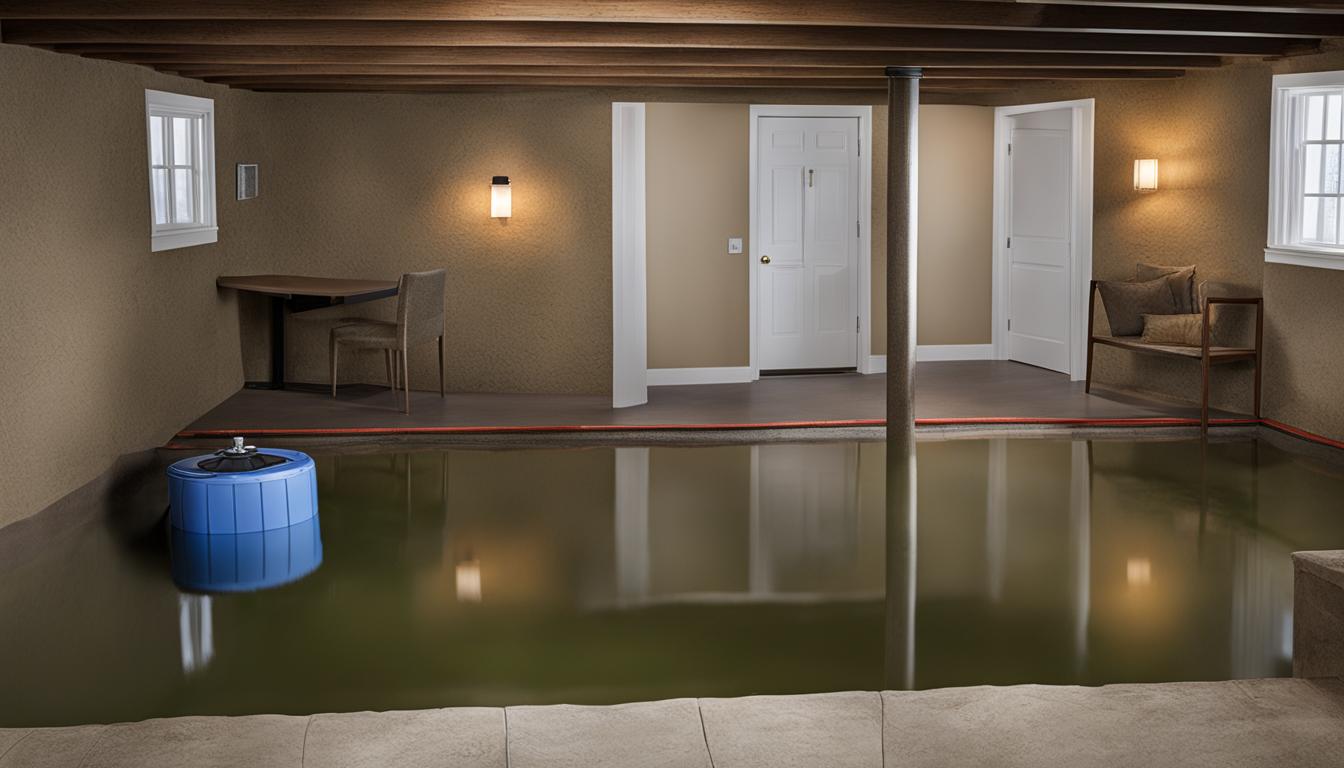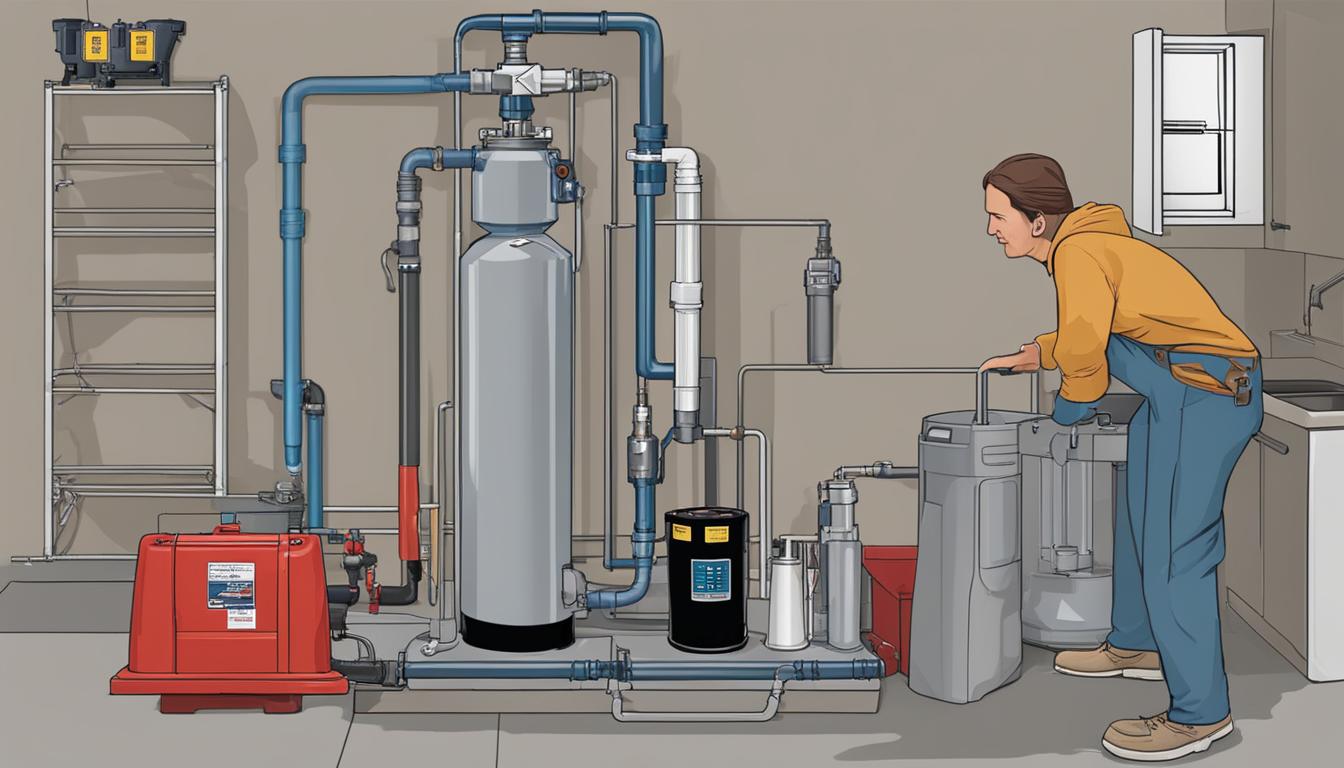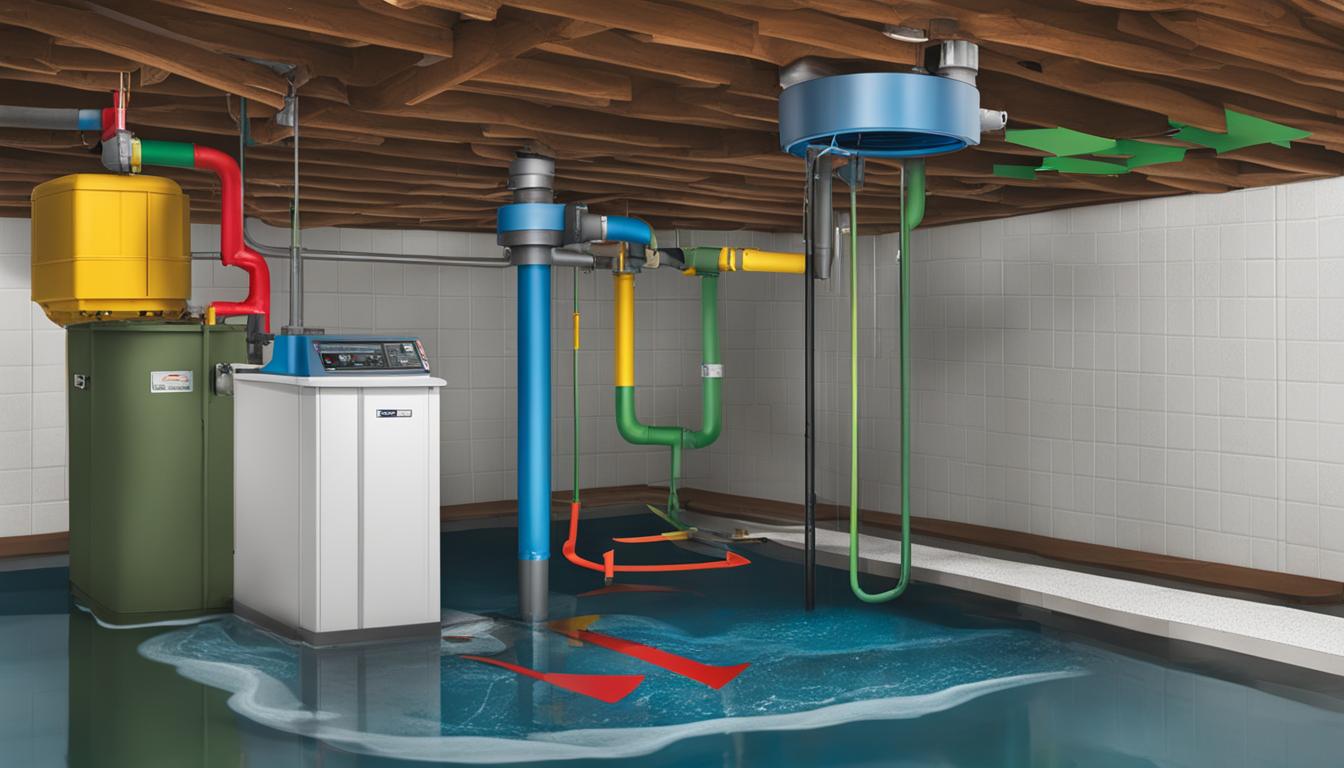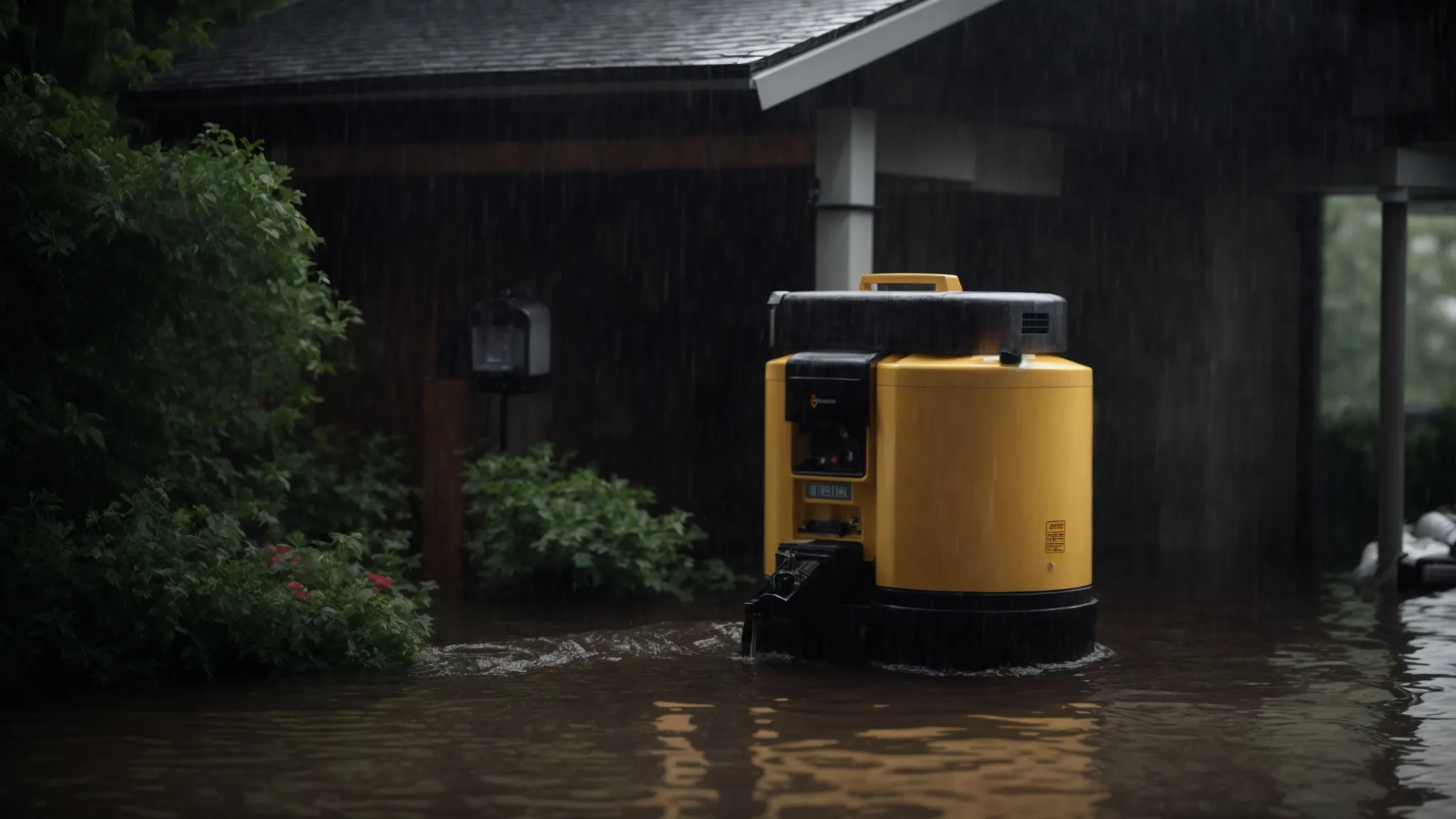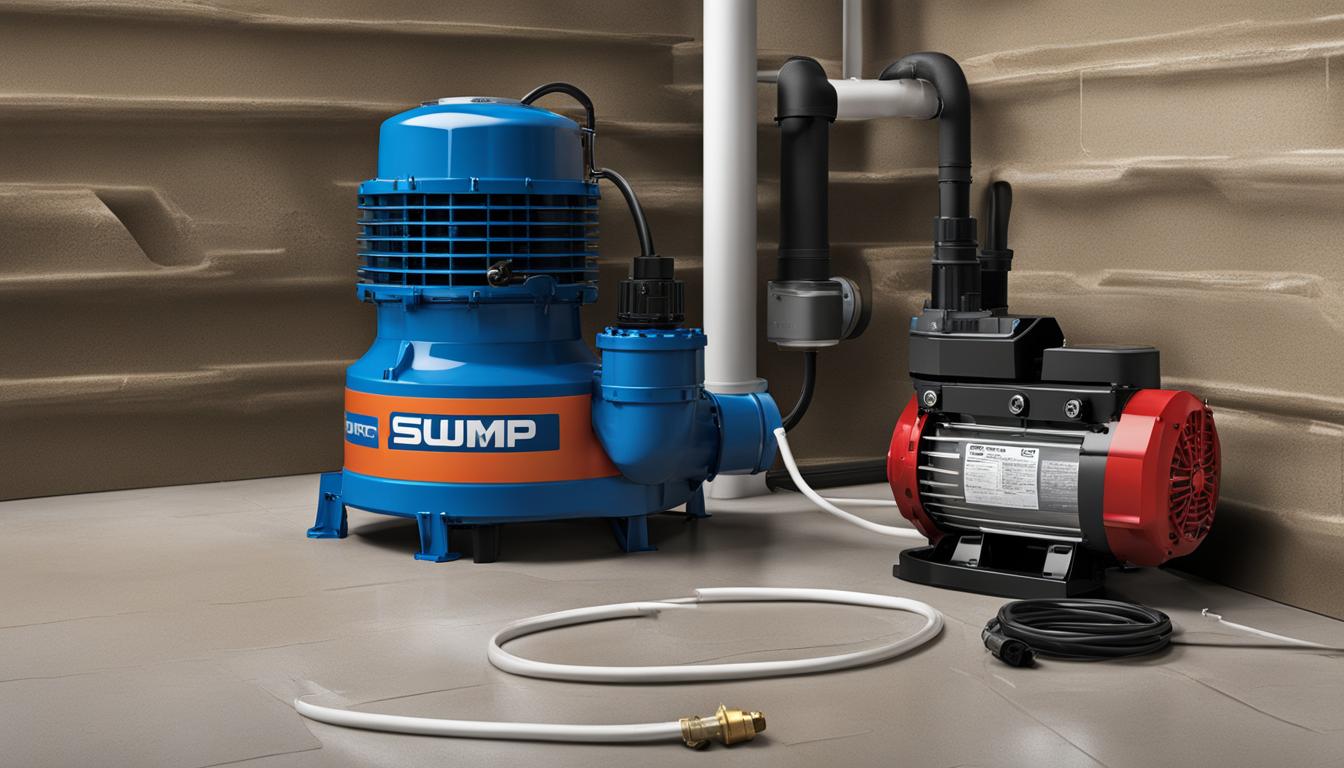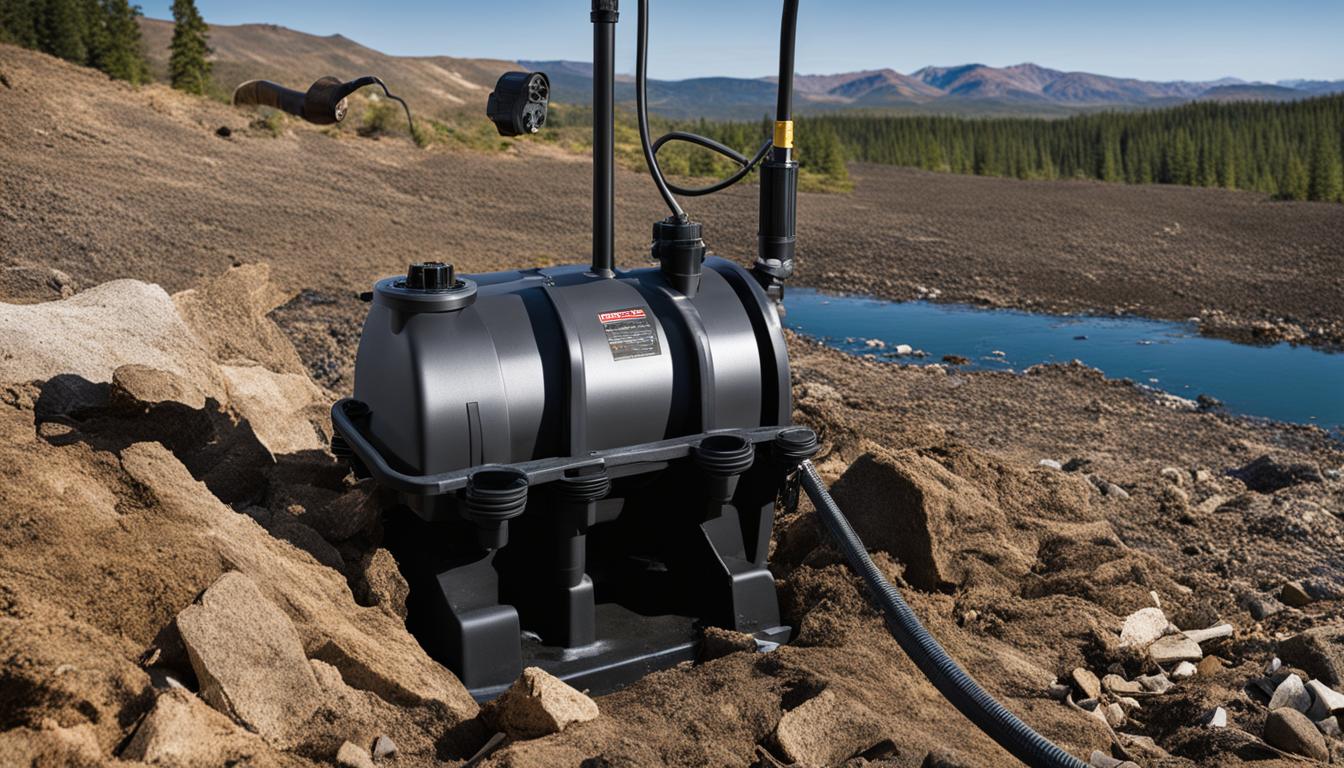Home safety is a top priority for every homeowner. Water damage, in particular, can cause significant harm to a property and incur costly repairs. That’s where sump pumps with built-in alarms come in – offering an extra layer of protection for your home. In this section, we will dive into the importance of preventing water damage and how sump pumps with built-in alarms can enhance the security of your home.
Key Takeaways:
- Sump pumps with built-in alarms are a valuable security measure for every homeowner
- Preventing water damage is crucial to avoid costly repairs and maintain a safe home environment
- Sump pumps with built-in alarms offer an extra layer of protection by providing early warnings of potential flooding
- Investing in a sump pump with built-in alarms can provide peace of mind knowing your home is secure
The Importance of Sump Pump Security
At its core, the sump pump serves as a defense mechanism against water damage caused by flooding or excessive rainfall. Flood prevention is a crucial aspect of home safety, making sump pump security a top priority for all homeowners. With the right safety features in place, sump pumps can provide a reliable and efficient solution to defend against water damage and protect your property.
Sump Pump Security
A reliable sump pump system is essential for flood prevention and basement security. The sump pump can remove water from the pit, helping to prevent flooding and water damage. While all sump pumps are equipped to perform this crucial function, not all offer the same level of security. That’s why it’s important to invest in a system that comes equipped with advanced safety features.
Flood Prevention
The primary goal of any sump pump is to prevent flooding. Water damage can result in costly repairs and create an unsafe living environment. A sump pump with built-in alarms can help prevent flooding by alerting you when water levels become too high. This early warning system provides essential time to take action and prevent extensive water damage to your home.
Safety Features
Some of the essential safety features that come with sump pumps with built-in alarms include water level alerts, battery backup systems, and overload protection. Water level alerts notify homeowners when the water levels in the pit become too high. Battery backup systems ensure that the sump pump keeps functioning even during a power outage. Overload protection helps prevent the pump from burning out due to excessive use.
Conclusion
Sump pump security and flood prevention should be a top priority for all homeowners. A reliable sump pump system can provide a crucial layer of security against water damage and protect your property from costly repairs. Investing in a sump pump with built-in alarms and advanced safety features can provide peace of mind and safeguard against potential disasters.
How Sump Pumps with Built-In Alarms Work
Sump pumps with built-in alarms are advanced systems that can detect water levels and provide early warning systems for potential flooding. These pumps are equipped with various safety features, including alarms, air switches, and battery backups to ensure reliable performance.
The built-in alarms in sump pumps are designed to provide users with water level alerts. They can detect if the water level rises above the predetermined level and notify users with an alarm or alert system. This feature is particularly useful for users who are away from their home or office for extended periods.
Sump pumps with built-in alarms also offer early warning systems for potential flooding. The pump can detect if the water level rises too quickly and alert the user that there may be a blockage or other issue. This allows for quick action to be taken and can prevent significant water damage.
How Sump Pumps with Built-In Alarms Work
| Components | Functions |
|---|---|
| Built-in Alarm | Provides water level alerts and early warning systems for potential flooding |
| Air Switch | Helps prevent water damage by automatically shutting off the pump when water levels become too high |
| Battery Backup | Allows the pump to continue functioning even during power outages |
The air switch in sump pumps with built-in alarms is another essential safety feature. It helps prevent water damage by automatically shutting off the pump when water levels become too high. This feature can prevent the pump from burning out or malfunctioning due to overuse.
Finally, sump pumps with built-in alarms are equipped with battery backups to ensure reliable performance during power outages or other emergencies. The battery backup enables the pump to continue functioning even if the power goes out, providing users with added peace of mind.
Overall, sump pumps with built-in alarms are essential for home safety and water damage prevention. They provide an extra layer of security and early warning systems for potential flooding. To ensure optimal performance, it is important to regularly maintain and check the pump.
The Benefits of Sump Pumps with Built-In Alarms
Investing in a sump pump with a built-in alarm can offer numerous benefits, including enhanced basement security, improved overall home safety, and increased peace of mind. Let’s take a closer look at these advantages:
| Benefits | Details |
|---|---|
| Basement Security | A sump pump with a built-in alarm can detect water intrusion before it causes significant damage. The alarm sounds when water reaches a predetermined level, alerting homeowners to potential issues. Early detection can prevent flooding and costly repairs. |
| Home Safety | Water damage can lead to electrical hazards, mold growth, and structural damage. A sump pump with a built-in alarm can help prevent these dangers by keeping water out of your basement and safely discharging it away from your home. |
| Peace of Mind | Knowing that your sump pump is equipped with a built-in alarm can provide peace of mind, especially during heavy rainstorms or periods of high groundwater. Homeowners can rest easy knowing that their sump pump will alert them in case of any potential issues. |
Overall, a sump pump with a built-in alarm offers an extra layer of protection against water damage and can help keep your basement safe and dry.
Top Picks: Sump Pumps with Built-In Alarms
Investing in a reliable sump pump with a built-in alarm is a valuable measure to enhance the security of your home and prevent water damage. We have researched and compiled a list of our top picks for the best sump pump models with built-in alarms.
| Model | Features | Price |
|---|---|---|
| Wayne CDU980E | Built-in Alarm, Vertical Float Switch, Durable Cast Iron Base and Stainless Steel | $$$ |
| Zoeller M63 | Built-in Alarm, Vertical Float Switch, Cast Iron Housing, and Thermoplastic Base | $$$ |
| Simer 2925B | Built-in Alarm, Vertical Float Switch, Thermoplastic Construction, and Convenient Size | $$ |
| Superior Pump 92341 | Built-in Alarm, Vertical Float Switch, Thermoplastic Construction, and Energy-Efficient | $$ |
Our top pick is the Wayne CDU980E. This pump offers a built-in alarm for early warning detection, a vertical float switch for consistent performance, a durable cast iron base, and stainless steel construction for extended longevity. Although a bit pricier than other models, it is the most reliable and efficient option on the market.
Zoeller M63 is another great option. It features a built-in alarm, vertical float switch, and a cast iron housing with thermoplastic base for maximum durability. Although slightly more expensive than the Super Pump and Simer models, it offers a longer lifespan and greater performance capacity than these pumps.
The Simer 2925B is a budget-friendly choice that offers a built-in alarm, vertical float switch, and thermoplastic construction in a convenient size. While it may not be as powerful as the Wayne or Zoeller models, it is a reliable option to consider for smaller households or individuals on a budget.
The Superior Pump 92341 is another affordable option. It features a built-in alarm and vertical float switch, as well as energy-efficient technology to save on electricity costs. Although not as durable as other models, it is a reliable choice for those seeking an affordable sump pump with built-in alarm.
Installation and Maintenance Tips
Proper installation and regular maintenance are crucial to ensure sump pumps with built-in alarms function smoothly and provide the necessary protection for your home. Here are some useful tips to guide you through the process.
Installation Tips
Before starting the installation process, it’s essential to gather all the necessary tools and equipment. Some of the tools you will need include a hacksaw, screwdriver, and a utility knife. Once you have everything, you can follow these steps:
- Begin by selecting the location for the sump pump. It should be in a low-lying area of your basement or crawl space.
- Next, dig a hole that is deep enough to accommodate the sump pit and pump. The hole should be wide enough to allow for easy installation and maintenance.
- Place the sump pit in the hole and ensure that it is level. Use a gravel base around the pit to ensure proper drainage.
- Connect the discharge pipe to the pump and place it inside the pit.
- Install the check valve on the discharge pipe to prevent backflow.
- Attach the alarm to the sump pump and install it according to the manufacturer’s instructions.
- Test the pump and alarm to ensure everything is working correctly.
It’s crucial to ensure that your sump pump is properly installed for optimal performance. If you’re not confident in your DIY skills, it’s best to hire a professional to handle the installation.
Maintenance Tips
Regular maintenance is essential to keep your sump pump in good working condition. Here are some tips to follow:
- Inspect your sump pump regularly to check for any signs of damage or wear and tear.
- Test the sump pump at least once every three months to ensure it’s working correctly.
- Clean the sump pump pit to remove any debris that may interfere with the pump’s operation.
- Replace the battery and test the backup system to ensure it’s working correctly.
- Check the discharge pipe regularly to ensure it’s not clogged or frozen.
- Replace any damaged or worn-out parts as soon as possible.
Regular maintenance will help prevent any potential problems and ensure that your sump pump with built-in alarms is ready to protect your home in case of any water-related emergencies.
Common Issues and Troubleshooting
While sump pumps with built-in alarms are designed to prevent water damage, they may encounter problems that need attention. Here are some common issues you might face:
| Problem | Cause | Troubleshooting Tips |
|---|---|---|
| The pump does not turn on when water levels rise. | The float switch is stuck or broken, or the pump is not receiving power. | Check the switch and ensure it moves freely. Check the power supply and outlet, and inspect the cord for damages. If necessary, call a professional for repairs. |
| The pump runs continuously. | The float switch is improperly adjusted or broken. | Adjust the switch to the correct height or replace it. Ensure the switch is not obstructed by debris or the pump itself. |
| The pump is making strange noises. | The impeller is clogged or damaged, or the motor bearings are worn out. | Clean the impeller of debris or replace it if damaged. Replace worn-out motor bearings. |
If you encounter any other issues that are not listed here, or you are uncertain how to resolve them, it is best to contact a professional for assistance. Attempting to fix problems without adequate knowledge and experience can lead to further damages and safety hazards.
Tip: Regular maintenance can help prevent many of these problems. Refer to the maintenance checklist in section 10 for guidance on how to keep your sump pump system in optimal condition.
Additional Safety Measures
While sump pumps with built-in alarms offer excellent protection against flooding and water damage, it’s always wise to prepare for the worst-case scenario. In this section, we will discuss two additional safety measures that can complement your sump pump system: backup systems and battery-powered sump pumps.
Backup Systems
Backup systems are an ideal solution for those who live in areas that are prone to power outages. A backup system is an additional sump pump that is installed alongside your primary pump. It kicks in automatically if the primary pump fails or if there’s a power outage. Backup systems can run on battery power or rely on water pressure, providing homeowners with an extra layer of security.
It’s essential to ensure that your backup system is properly installed and maintained for optimal performance. It’s also important to choose a reputable company to install your backup system and sump pump to ensure they work together seamlessly.
Battery-Powered Sump Pumps
Battery-powered sump pumps are an excellent option for those who want a reliable backup during power outages. These pumps are designed to work independently of your primary sump pump and can operate for several hours using battery power.
Battery-powered sump pumps are easy to install and require minimal maintenance. They are also an affordable option for homeowners who want extra protection without breaking the bank.
| Backup Systems | Battery-Powered Sump Pumps |
|---|---|
| Installed alongside primary pump | Designed to work independently |
| Provides an extra layer of security | Operates for several hours using battery power |
| Can run on battery power or water pressure | Easy to install and require minimal maintenance |
Overall, backup systems and battery-powered sump pumps are excellent options for homeowners who want to enhance their sump pump system’s effectiveness. They provide an extra layer of security and peace of mind, ensuring that your home is protected from flooding and water damage, even during power outages.
Professional Installation vs. DIY
When it comes to installing a sump pump with a built-in alarm, homeowners have two options: professional installation or DIY. Both approaches have their pros and cons, and the right choice depends on several factors.
Professional Installation
Professional installation of a sump pump offers many advantages. First and foremost, it ensures that the pump is installed correctly and to the manufacturer’s specifications. This helps to prevent any mishaps or issues that may arise due to improper installation. Additionally, professional installation provides the homeowner with peace of mind, knowing that the job has been done right by an expert.
However, professional installation can be expensive. This is especially true if the homeowner needs to install a new sump pump system altogether, which may require additional plumbing work or electrical wiring. Homeowners should consider the cost of professional installation and factor it into their budget accordingly.
DIY Installation
DIY installation of a sump pump is a more budget-friendly choice for homeowners. It allows them to save money on the installation costs and gives them the satisfaction of completing the project themselves. DIY installation can also be a fun and rewarding experience for those who enjoy tackling home improvement projects.
However, DIY installation requires a certain level of knowledge and skill. Homeowners should be comfortable with basic plumbing and electrical work, as well as following instructions carefully. Improper installation can lead to a malfunctioning sump pump, which can result in damage to the home and costly repairs.
Our Recommendation
Overall, the choice between professional installation and DIY installation depends on the homeowner’s level of comfort and budget. If the homeowner can afford professional installation and wants the extra peace of mind, then that is the best choice. On the other hand, if the homeowner is handy and confident in their abilities, then DIY installation may be a viable option. Regardless of which option the homeowner chooses, it is essential to prioritize safety and ensure that the sump pump is installed correctly and maintained regularly.
Maintenance Checklist for Sump Pumps with Built-In Alarms
Maintaining your sump pump with a built-in alarm is crucial to ensure that it functions optimally, especially during times of heavy rain or severe weather conditions. Regular maintenance can help prevent malfunctions and extend the lifespan of your sump pump. Here is a comprehensive maintenance checklist to help you keep your sump pump in top condition:
1. Check the Alarm
Test your pump’s alarm regularly to ensure that it is functioning correctly and can provide an early warning in case of an emergency.
2. Inspect the Pump
Check the pump and its components for signs of wear and tear, corrosion, or damage. Make sure that it is not clogged with debris or sediment and that it is properly mounted.
3. Clean the Pump
Remove any debris, dirt, or sediment from the pump and its components, including the switch, discharge line, and valve. Ensure that there is no buildup, which can impede the pump’s performance.
4. Test the Switch
Test the switch to ensure that it activates when the water level rises. Check that it is not sticking or malfunctioning in any way that could prevent it from activating the pump when needed.
5. Verify the Discharge Line
Verify that the discharge line is connected correctly and is not obstructed in any way. Ensure that the line is pointed away from the foundation and is at least 10 feet away from the house to prevent water from re-entering the basement.
6. Install a Backup System
Consider installing a battery-powered backup system to ensure that your sump pump continues to function in case of a power outage or failure.
By following this maintenance checklist, you can ensure that your sump pump with a built-in alarm is always ready to protect your home from water damage. Regular maintenance is essential to keep your pump in top condition and provides you with peace of mind in case of an emergency.
Conclusion
Investing in a sump pump with a built-in alarm is an important step in protecting your home from water damage and ensuring the safety of your family. These pumps offer an extra layer of security, providing early warning alerts and preventing potential flooding.
In conclusion, we have seen the significance of sump pump security, how these pumps work, and the benefits they offer. We have also provided our top picks for the best sump pump models with built-in alarms and shared installation and maintenance tips to ensure optimal performance.
Regular maintenance is crucial, and we have provided a checklist to help you keep your sump pump operating smoothly. Lastly, we discussed additional safety measures such as backup systems and battery-powered sump pumps.
Overall, we encourage you to prioritize home safety and invest in a reliable sump pump system with a built-in alarm. With these valuable security measures in place, you can have peace of mind knowing your home and family are protected.
FAQ
What are sump pumps with built-in alarms?
Sump pumps with built-in alarms are devices that help prevent water damage in your home by monitoring water levels in the sump pit and providing alerts in case of any abnormal rise. They act as early warning systems for potential flooding.
Why is sump pump security important?
Sump pump security is crucial because it helps prevent flooding and water damage in your home. A reliable sump pump system can protect your basement and other vulnerable areas, ensuring the safety of your property and belongings.
How do sump pumps with built-in alarms work?
These pumps work by continuously monitoring the water level in the sump pit. If the water rises to a certain level, the built-in alarm is triggered, alerting you to a potential flooding situation. This allows you to take prompt action and prevent water damage.
What are the benefits of using sump pumps with built-in alarms?
Sump pumps with built-in alarms offer several benefits. They enhance basement security, provide an extra layer of protection against water damage, and give homeowners peace of mind. With these pumps, you can monitor water levels and respond quickly to any potential flooding.
What are the top picks for sump pumps with built-in alarms?
We have selected the best sump pump models with built-in alarms in the market. Our top picks offer reliable performance, advanced features, and efficient water management. Check out our detailed overview of these models to find the best fit for your needs.
How do I install and maintain sump pumps with built-in alarms?
Installing a sump pump with a built-in alarm requires following a few steps. We provide useful tips and guidelines for proper installation. Additionally, we offer maintenance tips to ensure optimal performance. Regular maintenance is key to ensuring your sump pump functions smoothly.
What are some common issues with sump pumps and how can I troubleshoot them?
Sump pumps may encounter common issues such as clogging, motor failure, or switch problems. We address these issues in detail and offer troubleshooting tips to help you identify and resolve the problem. Proper troubleshooting can keep your sump pump system running effectively.
Are there additional safety measures that can complement sump pumps with built-in alarms?
Yes, there are additional safety measures you can consider. Backup systems and battery-powered sump pumps provide an extra layer of security in case of power outages. These options ensure continuous operation and protect your home even during electrical disruptions.
Should I opt for professional sump pump installation or DIY?
Choosing between professional sump pump installation and DIY depends on your comfort level and expertise. We weigh the pros and cons of both approaches to help you make an informed decision. Professional installation ensures accuracy, while DIY installation can be cost-effective if you have the necessary skills.
What should be included in the maintenance checklist for sump pumps with built-in alarms?
Regular maintenance is crucial for optimal sump pump performance. Our maintenance checklist provides step-by-step instructions on how to maintain your sump pump with a built-in alarm. Following this checklist helps prevent issues and ensures your pump operates effectively when needed.
